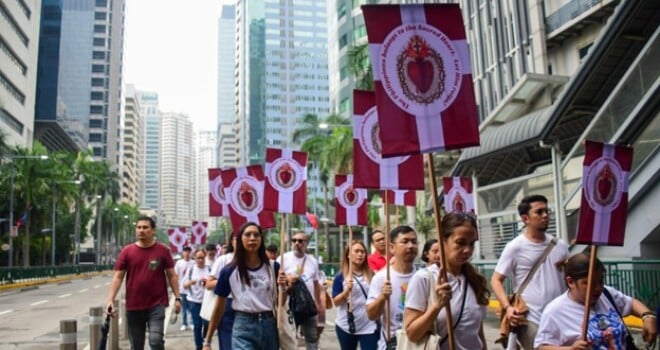As we conclude a month that not only normalizes sexual immorality but glorifies it, we can draw hope from a movement of young Catholics in the Philippines which organized prayerful “Humility Marches” in key cities throughout the country, offering a spiritual alternative to secular Pride Month celebrations.
The “Humility March” is a city-wide Eucharistic procession and public act of reparation to the Sacred Heart of Jesus, “specifically during a month that the Sacred Heart suffers so much blasphemy and indifference.” It was pioneered by a Filipino youth who was saddened by what he saw on his Jesuit University Campus.
“I started the ‘Humilitas March’ because of an inspiration I received one day. In June 2023, I was walking around the campus of my university when I saw a crowd promoting the vice of Pride, waving their flags in a university dedicated to Our Lady. Then I felt this pain deep in my heart because I could not understand how it was possible for a Catholic university to allow an event that promotes vice and pushes for an ideology that is contrary to the truths of our faith,” shared Raven Castañeda, the college student who founded the movement.
Castañeda then went to the adoration chapel to pray before the Blessed Sacrament. Raven and some friends had restored the Holy Hour devotion in that very chapel on their college campus, after they had been told it was lost for nearly 20 years. “But when I pushed open the heavy metallic door, I found an empty chapel,” he said.
“As I raised my eyes to the cross, I found Jesus Christ silent and humble before the noise of the proud crowd . . . just like when He stood before Pilate, just like when He was mocked by the soldiers and the Pharisees. But it’s not just the crowd of pride, it is also the masses of indifferent Christians who merely pass Him by as He awaits for them in the tabernacles of churches, waiting for His love to be returned with love.”
“I knelt down and prayed, ‘Lord, let me console you in this dark hour. Let me receive all the love that was rejected today.’ . . . And in the silence of that chapel, I was moved to promote the Sacred Heart of Jesus.”
“I made a vow to God that in the following year, with the help of His grace, I would publicly wave the banner of His Most Humble and Most Sacred Heart to remind people that in this Heart is the Love that saves—the love that saves us from our own wretchedness; the love that gives us the peace that the world cannot give; the love that can provide us with the joy and the bliss that the world cannot even begin to comprehend.”
Castañeda and other volunteers tirelessly went door to door to different parishes to invite people to join the march. Their efforts paid off. Hundreds of Catholics—most of them youth—showed up. Notable organizations that joined included: Missionary Families of Christ, Singles for Christ, Youth for Christ, Pro-Life Philippines, Philippine Social Conservative Movement, The Sentinel Philippines, Conservatives of the Philippines, and priests and religious, among others.
The Philippines has long been devoted to Jesus’ Heart. It was first consecrated to the Sacred Heart of Jesus by President Ramon Magsaysay in 1956. Nearly four decades later, in June 1995, President Fidel Ramos, a Protestant, personally renewed this consecration.
Former Pride Marchers Join Humility March
Xyril, who attended a Pride March last year but joined the Humility March this year, shared:
“Last year, I joined a Pride celebration. I thought I had found what I was looking for—affirmation and freedom. I had a same-sex partner then, and for years, we had lived together. Her family became like my own. For a while, I believed I had finally found ‘home.’ But something inside me always felt sad, empty. I didn’t know why.”
They eventually separated, and Xyril had a conversion to the Faith after seeking God amidst her feelings of emptiness.
“I thought I had found love and identity, but deep inside, I always felt lost and incomplete . . . Eventually, I separated from her because the feeling of emptiness in me was so strong. I was seeking God, and so one day I decided to attend a Misa de Gallo,” a Mass at dawn, often celebrated for nine consecutive days as part of a novena. “I didn’t expect much, but surprisingly, I completed all 9 nights. I didn’t tell anyone though, especially not my Protestant father, who wouldn’t understand.”
She then tells of a vision she had seen once during Mass; when the priest was raising the consecrated Host, the “glowing heart” of Jesus appeared behind the priest, visibly reaching towards her. She said she was “fully awake, but it looked like a dream.” As a Protestant, she did not yet understand the Real Presence of Jesus in the Eucharist. But the experience was so profound that she felt strongly pulled to the Catholic Church.
“From that night on, I started searching. I read. I prayed more. I visited different churches. My soul began to hunger,” she said. Eventually, after receiving formation from a patient spiritual director whom she described as an “answered prayer”—she became a Catholic.
“When I heard about the Humility March this year, something stirred in me. I remembered the light I had seen behind the Host . . . the light that came from Jesus’ Heart, the longing ache in me for Him. I knew I had to walk—this time not to be seen by the world, but to walk towards the One who first reached out for me.”
“The Humilitas March wasn’t like Pride. It wasn’t loud or boastful. It wasn’t about being vainly adored, but about being seen by God. It wasn’t a protest, but a procession; I didn’t come to shout, I came to surrender; I didn’t walk in defiance, but in repentance. It was reverent and sacred. It felt like my homecoming to the Heart of Christ. After everything I’ve been through, I finally found where I belong—in His mercy, in His Church, and in His Sacred Heart.”
Leo, another attendee, shared, “I used to struggle with sexual sins, and even try to excuse it or justify it, telling myself it’s not really wrong because ‘everyone’s doing it anyway.’ But then I realized that’s what pride is. Pride says, ‘I will follow my own will, make my own rules, redefine gender, marriage, and sexuality the way I want it’—rather than following God’s will and design for sexuality. It’s ‘My will be done’ not ‘Thy will be done.’”
“Humility, on the other hand, submits to the Lordship of Jesus and obeys Him. If Jesus is truly my Lord, I should follow what He says in His Word, even if it’s hard sometimes. Jesus must be Lord over every aspect of my life—including my sexuality—or else He is not my Lord at all. This is why scripture says that no one can say ‘Jesus is Lord’ except by the Holy Spirit. That uncomfortable feeling I felt whenever I sinned sexually . . . that was the Holy Spirit convicting me,” he added.
Lester, an activist, also shared his story. “I only joined Pride Marches in the past because I am an activist, and as an activist, most of our advocacies are left leaning. But then I realized, I am a Catholic first, before an activist. And that realization hit me hard . . . When some of the things I fight for goes against my faith, then I must draw the line. I would rather offend all of my comrades than my God.”
Fr. Joel Jason, a Filipino priest known for his work promoting St. John Paul II’s Theology of the Body, explained that the devil’s tactic has always been the same: “Pride gives way to rebellion and mutiny against nature and creation. Pride says, ‘I am not a creature; I am my own creator.’ It is the original sin of the first man and woman that separated them from God.”
A “Humble” Movement
The movement is not meant to be a direct reactionary confrontation with Pride Marchers. Instead, it seeks to be a quiet and prayerful countermovement of Catholics publicly witnessing to their faith and making reparation for sins, amidst a society that publicly seeks to normalize, glorify, and celebrate sexual immorality.
“It’s not meant to be directly hostile or antagonistic towards Pride marchers. The aim of our initiative is simply to promote the Sacred Heart of Jesus and to encourage young Filipinos to find in His Heart a refuge for all their troubles,” shared Nirva Dela Cruz, who co-organized the march.
“We have grown so cold and indifferent to this Heart so tender and overflowing with love for us,” shared Christine May, a Sacred Heart devotee who wrote the march’s theme song. “Our hope is that the Sacred Heart of Jesus may be consoled by these acts of faith.”
Castañeda added, “We are taking our faith from the sanctuary to the streets, proclaiming the words of Jesus Himself [as told to St. Margaret Mary Alacoque]: ‘Behold this heart which has so loved men, that it has spared nothing, even to the point of exhausting and consuming itself to bear witness to its love. In return, I receive from the greater part of mankind only ingratitude, by the irreverence, sacrilege, coldness, and contempt they show me . . .’”
After the march, hundreds of youth signed a manifesto which reads: “We are the young Church of the Philippines. We are committed to promote and grow in our devotion to the Sacred Heart and the Eucharist; to walk with the poor, finding ways to serve them and to champion their cause—for in them, we see the Sacred Heart; to build a society where truth reigns and is guided by Christ’s teachings; and to evangelize boldly, even when it’s uncomfortable, strengthening communities that are formed in the orthodox Catholic Faith.”
Photo provided by the Author

















